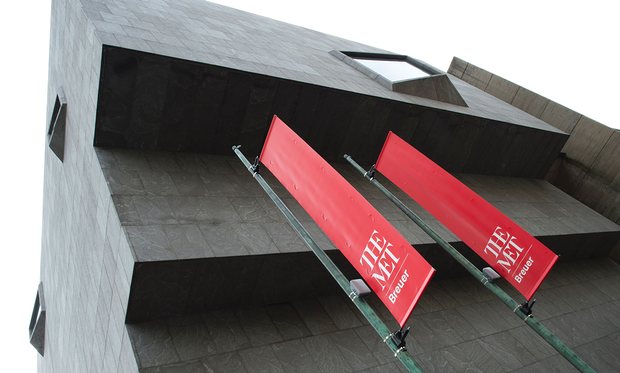The Metropolitan Museum wanted attention this spring, this year, what with the opening of the Met Breuer–and it’s sure getting it. Another magazine has had its crack at interpreting the Met’s renewed attention to contemporary art: The New Republic published “State of the Art: The Metropolitan Museum makes a bid for the modern“ the other day.
 I have to say it is disappointing. So why I am commenting on it? I tried mining for nuggets of insight but found more points that need amplifying, questioning and, yes, correcting.
I have to say it is disappointing. So why I am commenting on it? I tried mining for nuggets of insight but found more points that need amplifying, questioning and, yes, correcting.
Taking its points from its top to bottom, I am posting direct quotes from the article followed by my comments in italics and bolded:
“…the Metropolitan Museum of Art, the beaux arts behemoth on Manhattan’s Upper East Side, has been rather a dowdy operation…”  The word “dowdy” to describe the Met is very tiresome and utterly wrong. Elegant, sophisticated, tasteful–those are better adjectives for the Met. But the Met does not lack for style, which is the definition of “dowdy.” Queen Elizabeth’s wardrobe may be called dowdy, but not the Duchess of Cambridge’s–she’s classic and stylish, like the Met. and not “trendy.”
“…the courtly Frenchman Philippe de Montebello…” No, not right: “French-born” is accurate.
“…Susan Sellers, who was hired by Campbell in 2013 as the head of a newly reinvigorated department of design, described de Montebello’s Met as being “like a university,†a gaggle of somewhat disjointed faculties.” Now, how would she know? de Montebello left the Met in 2008. Ms. Sellers arrived five years later. Is she relating hearsay? She did not come from the museum world. Previously, she had been a founding partner and the creative director of 2×4 and Senior Critic in Graphic Design at Yale School of Art. Not a great source for that particular point. It is, of course, in her interest to say that what she inherited was a mess; it makes whatever she does look better.Â
“…The move into the Met Breuer…was arranged in part to accommodate a massive trove of modern art donated to the Met by cosmetics magnate Leonard Lauder.” Well, not exactly. Lauder bequeathed his collection to the Met; aside from the occasional loan, it resides in his apartment. The Met has an eight-year lease on the Breuer, though it is, I believe, renewable. But that sentence implies that the Met has that massive trove now, or will have–because Lauder dies–before the lease expires. I wouldn’t count on that. Â
“The $1.1 billion Lauder gift instantly made the Met into a prime destination for twentieth-century paintings and sculpture.” Again, not really–not until Lauder dies. Definitely not “instantly.”
“Sheena Wagstaff, installed in 2012 as the first curator of Campbell’s department of modern and contemporary art.” Technically, this is true. But only because the Met has changed the name and dimensions of the department over the years. William Lieberman, you will recall, was hired in 1979 as “chairman of the Met’s department of 20th-century art.” It was renamed “the department of modern art” in 1999, and in 2004 it became “the department of 19th-century, modern and contemporary art.” No matter what you think of Lieberman’s view of contemporary art, he was the head of that department.Â
“A lumbering, top-heavy exercise in quasi-Brutalism, [the Breuer building]Â was not a building that played nicely with its Upper East Side neighbors…” Lumbering? Not the adjective I’d choose.Â
“More importantly, the show [Unfinished] affords a convenient device for cutting into a deep core sample of the Met’s collection—featuring, of course, some of the recent Lauder contributions…” Again, not quite. According to the press materials provided to me by the Met, there is one painting in Unfinished from The Leonard A. Lauder Cubist Collection: Cezanne’s Bouquet of Peonies in a Green Jar, ca. 1898.Â
“Unlike Lauder, the Rockefellers were not major players in a white-hot art scene that has seen the world’s wealthy turn to auctioneers, gallerists, and private dealers as de facto bagmen for converting cash into portable artistic investment vehicles.” Now this does a real disservice to Lauder; he is far from a bagman who converted art to cash. I believe (but would have to double-check) that Lauder bought most of his collection in the ’80s and ’90s, though he keeps buying–for more than one collection; I know he assembled the Cubist collection quietly, when it was not fashionable to collect Cubism, with a careful vision and sold rarely, if ever. Â
“The Whitney, smaller and more nimble, charged with an experimental sensibility that it sees as intrinsically American, was perhaps better able to produce shows of greater originality and freshness during its Madison Avenue residency than the slower, larger Met can hope to do in the same setting. And if the Met, with all its historical baggage tries too hard to be the Whitney, the results could be awkward.” This is revisionism: for how many years was the Whitney, right or wrongly, known as the enfant terrible of the NYC museum scene, the place that got so many things wrong? The author did use the word “perhaps.” Good thing.Â
“No longer just a storehouse for Greco-Roman artifacts and impressionist blue-chip paintings, the Met is now a serious contender in the fast-paced modernist marketplace.” C’mon–this leaves out the Islamic, Asian, Egyptian, American, decorative arts, costume and other departments.Â
I’m writing this for one reason only: I don’t want these points to be taken as gospel–or worse, repeated. I don’t want people who don’t know the Met to be guided by the impression this article leaves.
Photo Credit: Courtesy of the Guardian
